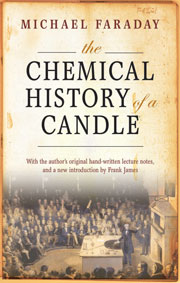"The Chemical History of a Candle" by Michael Faraday
A series of six lectures given by the natural philosopher Michael Faraday, in which he describes what happens when a candle is lit. Written in 19th-century English, it is not a clear or precise as science books written today, but I really enjoyed it because it was lovely to take something so small and everyday as a candle and break down everything that happens with it, from how they are made to the carbon dioxide (or carbonic acid) that is produced in combustion. He even links together the combustion of a candle and human inhalation/exhalation. The knowledge that he displays is incomplete and sometimes told in a weirdly romantic fashion (especially the last paragraph), but mostly this is what I have come to expect from older science books. These lectures were taken down by a stenographer--they are word-for-word from Faraday's mouth.
A good book for a beginner and someone interested in the history of science.
About the Author: Michael Faraday (1791-1867) was a "natural philosopher" (AKA chemist or physicist) from England. Although he came from a poor background, he bravely sent off letters to scientists, hoping for a chance in a laboratory. Sir Humphrey Davy hired him because of a temporary eye injury, and Faraday's job became permanent after he made a good impression. This brought Faraday to the Royal Institution, which would become linked with his name forever--partially because he helped save it from bankruptcy. When the Royal Institution began giving lectures, he first served as an assistant, but then later gave lectures of his own--one of which was "The Chemical History of a Candle." After forty-plus years of giving these popular lectures, he resigned in 1861.

No comments:
Post a Comment